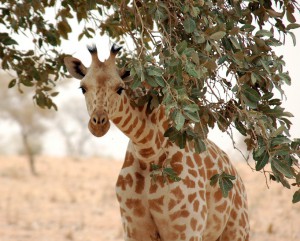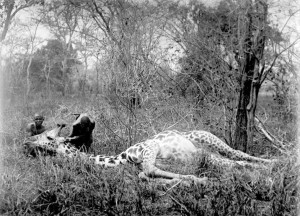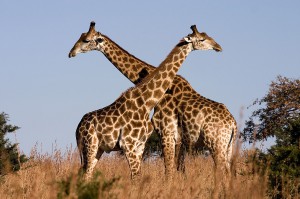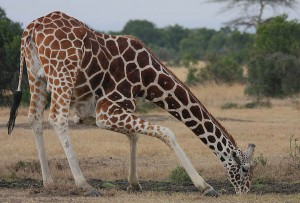The number of giraffe subspecies, and the relationship between them, remains controversial. Research, published in BMC Evolutionary Biology, uses a new analysis of mitochondrial DNA to help resolve these questions, with implications for the conservation of these unique animals.
How to recognise a giraffe
Giraffes, unsurprisingly for such distinct animals, have long attracted considerable interest from we humans. Despite this we still lack a lot of basic knowledge about these animals.

For example, just how many species of giraffe are there? Currently, biologists recognise just one species of giraffe, but nine distinct subspecies. Some researchers have suggested that at least some of these subspecies should actually be classified as separate species.
Part of the reason for this confusion is the lack of a clear way to identify the different subspecies. Identification is primarily based on the pattern of a giraffe’s coat and characteristics of its ossicones (the horn-like structures on their heads). This is problematic, as there is considerable variability in these characteristics within subspecies too.
The modern day solution to these kind of problems is usually analysis of an individual’s DNA, but unlike for other African wildlife (like elephants or lions) there is a lack of genetic analyses for giraffes across their whole geographic distribution. One previous study using genetic data from six of the nine subspecies supported the idea of more than one distinct giraffe species, but in general such studies have suffered from limited sampling.
How to conserve a giraffe
These questions are important for reasons beyond intellectual curiosity; they have important implications for giraffe conservation. Giraffe populations across Africa have shrunk considerably in recent years, due to habitat loss and poaching; best estimates suggest there are now less than 80,000 individuals left. This has created a need to know where and how many genetically distinct giraffe populations there are, in order to properly focus conservation efforts.

There is also an increasing trend for individual giraffes to be moved from one area to another by humans; sometimes to restock depleted populations for conservation purposes, but increasingly for the purely economic reason of encouraging wildlife tourism. Doing this without accurate knowledge of the relationships of giraffes in these different areas is potentially damaging.
New research, published this month in BMC Evolutionary Biology, looks to extend our knowledge of taxonomic relationships among giraffes. The study, led by Julian Fennessy of the Giraffe Conservation Foundation, in collaboration with researchers in Germany, Australia and South Africa, focused on giraffes in southern Africa, particularly Namibia and Botswana.
Tissue samples were collected from eight of the nine currently recognised giraffe subspecies by remote biopsy; giraffes were shot with a dart gun allowing samples to be collected non-invasively. Mitochondrial DNA was extracted from these samples, allowing the researchers to estimate relatedness of the giraffe populations through phylogenetic analysis of two regions of the mitochondrial genome.
Giraffe relationships
The new study broadly supports the currently recognised list of sub-species; every one of the newly sampled individuals was associated with the expected sub-species based on geographic location and appearance. This suggests that there is not large scale natural migration of females between giraffe populations and, perhaps more importantly, that translocations by people are not creating unnatural mixtures of different subspecies.

The researchers have a particular interest in the identify of giraffes in northern Botswana and north-eastern Namibia. Which subspecies occupies these regions is unclear; Angolan giraffes, widely found west of these areas, or South African giraffes, found south and east of here – or a mixture of both.
The new data reveals a rather complex pattern; both subspecies are found in these areas, but in distinct populations. For example, individuals with South African giraffe DNA are found both north and south of a population of Angolan giraffes in the Central Kalahari Game Reserve in Botswana. However, despite the close geographic location of the two sub-species, the new research suggests that genetically they are far apart. This suggests that for conservation purposes it is important to take measures to protect the giraffe populations outside of the protected game reserve, in order to preserve as much giraffe diversity as possible.
An ancient rift
What is the reason for such a strong genetic split between two sub-species that are geographically so close (within walking distance for giraffes)? The division appears to be an ancient one, originating in the Pleistocene, 1.4 million years ago. This suggests there was once a barrier splitting the two populations.
The researchers explain this pattern by proposing the existence of a “cryptic” rift valley. A known geographic boundary runs through this region of Africa today, forming a subtle but distinct line between the Angolan and South African giraffe subspecies. Today this area only holds water during the rainy season and does not provide a barrier to giraffe dispersal. However, if this barrier was bigger during the Pleistocene it could have created a physical barrier between the ancestors of the two subspecies. Previous geological research in the area has indeed found evidence for the presence of substantial lakes and forests in northeast Botswana during this period.

A vast rift valley, running southwest across Botswana and containing a mosaic of aquatic and moist forest habitats, would have provided a substantial barrier separating the giraffe populations on either side, allowing them to slowly evolve into the two distinct subspecies we see today. Although this barrier is now gone and the two populations could intermix, behavioural factors, such as a preference for mates with a specific coat pattern, likely ensure this genetic separation is maintained.
Such a “cryptic” rift valley could also explain the similar observations of geographically close but genetically distinct populations in other animals in this part of Africa, such as elephants and impalas.
Still more to do
Further studies will still be necessary to fully uncover the relationships between giraffes in southern Africa and elsewhere. In particular, studies using nuclear DNA might uncover different relationships than studies, like this one, using mitochondrial DNA which, being inherited only via the female line, does not take into account dispersal of males between populations.
This new research does make the obscure relationships of the giraffe that much less opaque, helping us both satisfy our curiosity and, hopefully, contributing to conserving these magnificent animals for future generations.
Comments